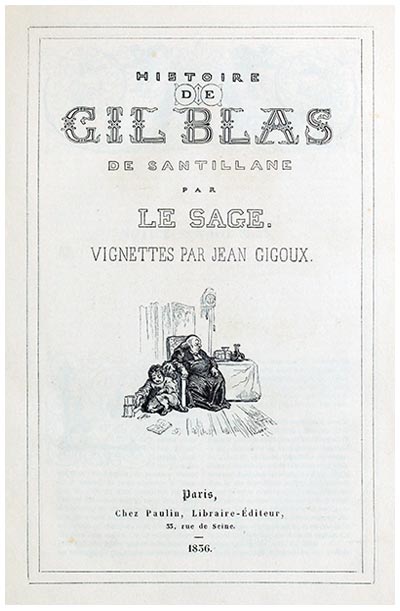Jean Gigoux on Gil Blas Illustrating Books in the Mid-1830s

Gil Blas (Histoire de Gil Blas de Santillane) wasn't the first illustrated French book of the Romantic era. To name only two, Légendes, ballades et fabliaux by Bahour-Lormian (1829), Nodier's Histoire du roi de Bohême et de ses sept châteaux (1830), illustrated respectively by Achille Devéria and Tony Johannot, already incorporated plenty of in-text illustrations. They, too, relied on the technique of wood engraving elaborated by Thomas Bewick, which would become the hallmark of the Romantic vignette: carving the woodblock against the grain with a burin.
What makes Gil Blas a milestone in the history of French Romantic publishing, along with Paul et Virginie and a few others, is that it was the first book to use the Romantic vignette so profusely, to give illustration such an prominent part, and to herald its commercial success so resoundingly: with its 600 illustrations drawn by Jean Gigoux and its ornate initial letters designed by François-Louis Français, at the time a pupil of Gigoux's, Gil Blas sold very well and was extremely profitable for its publishers.
The following is a short, but first-hand account—that of Gigoux himself—of the process that lead from the initial deal for one hundred illustrations to the increasing demands of the publishers as the book met with public success, and of the way illustration work was carried out in France in the mid-1830s.
In 1835, I did my illustrations for Gil Blas. Here is how: One day I was asked to create one hundred illustrations for a new edition of this wonderful book. I must admit that I had a moment of terror, almost. It seemed to me that I could never find one hundred subjects for compositions in it. Yet, I did them. A few days later, the publishers asked me for three hundred more. So I started reading again, and sketching my illustrations as I went along. The following week, realizing the appeal that these drawings gave to the installments, the publishers asked me for two hundred more. In short, I did six hundred illustrations, and I think I could have gone on forever.
Dubochet, one of the three publishers, had at the time a mere total of 14,000 francs with which the publishing was undertaken. Eight months later, however, on December 31, 1835, each one of them made a profit of 50,000 francs. As early as the first installments of Gil Blas, Dubochet had foreseen an excellent venture. For this reason, he didn't leave me all day. I had no sooner sketched out my woodblock than he took it to engraving without giving me time to finish it. This annoyed me, even humiliated me, as it has always been my principle to complete things. This Dubochet man was excessively harsh to his poor engravers. The slightest mishap cost them dearly, and oftentimes he would drag them to court. Note that he paid them very little, as he took on apprentices rather than seasoned engravers. in order to save these wretched people poorly paid effort, I made my conpositions as simple as possible and spared the shadowy parts as much as I could.
Now, listen to this: one day when I was tired out, I met with the three partners and, after stressing the enormous profits that Gil Blas earned, I asked if, in all conscience, I shouldn't be counted as a fourth partner and be granted my share, at least from the fifteen thousandth copy on. All at the same time replied: Yes, absolutely! We'd really be too rich if we made it to that many prints.
Later, when the said fifteen thousand copies had long been exceeded, I met with them again to remind them of their promise. They were appalled. No one wanted to be the first to answer. Finally, Dubochet, who knew no shame, bluntly told me that the deal was too good to be shared and that I would lose the case in court anyway as nothing was written.
Introduction and translation by OBI
The main content of this article was taken from Causeries sur les artistes de mon temps by Jean Gigoux, Paris: Calmann Lévy, 1885.
